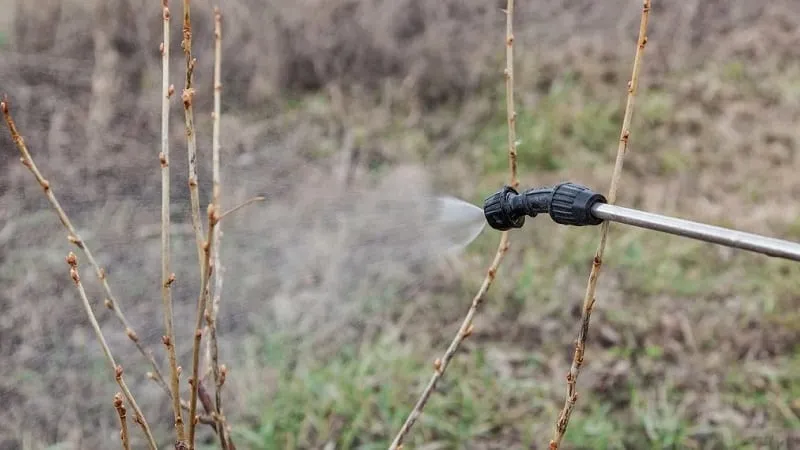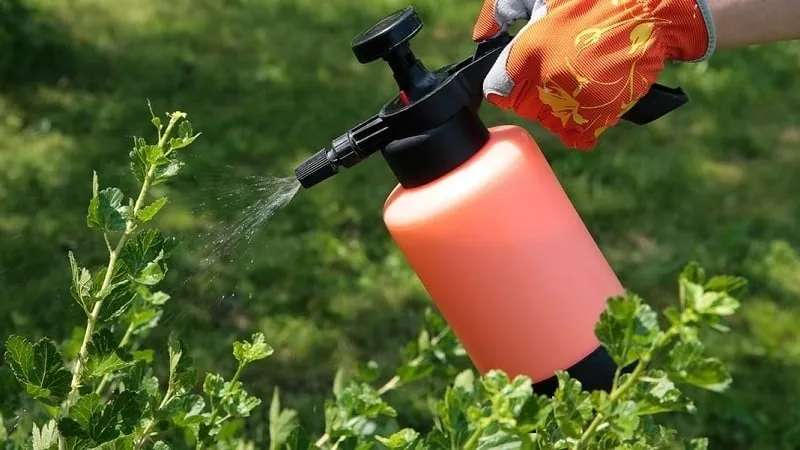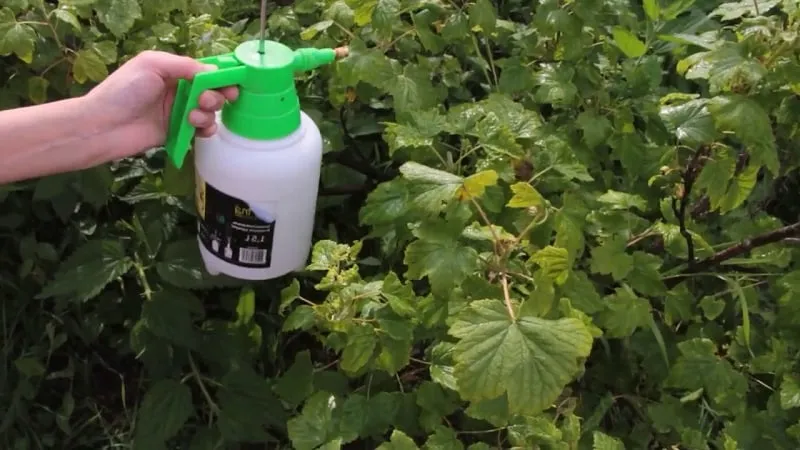Gooseberries are known for their low maintenance, but they are susceptible to powdery mildew, rust, anthracnose, and septoria. The sweet-sour berries and juicy foliage attract caterpillars, aphids, mites, and gooseberry moths. To protect your plants from infestations, preventive treatment in early spring is recommended, following a strict schedule. Learn which products are suitable for protecting gooseberries before bud swelling, during foliage growth, flowering, and fruiting in this article.
Table of contents
Treating Gooseberries for Diseases and Pests in Early Spring
In spring, gooseberries are among the first plants to emerge from dormancy, so they require immediate attention from the gardener. The first step is to inspect and remove dry and frost-damaged branches. Clear plant debris from the area and spray the bushes to prevent diseases and pests.

Before Flowering
Determining the exact timing for treating gooseberries against diseases and pests can be challenging. Experienced gardeners recommend focusing on the plant’s growth stage and starting treatment before buds open. The air temperature should be at least +5°C and remain stable for several days. Adhering to the schedule is also crucial due to the activity of caterpillars.
Before bud swelling, remove mite-infested buds, damaged and twisted shoots, and pour hot water over the gooseberries to prevent powdery mildew. For anthracnose prevention, treat the bushes once with products like Cuproxat or Funguran.
During bud swelling, spray the bushes with a 1% Bordeaux mixture to prevent leaf spot (anthracnose, septoria, rust). For mites, use Spidex or Vertimec, and for powdery mildew — Sulfur Jet. Preventive sprays against moths and caterpillars include Karate Zeon, Decis ProTech, and Calypso. Once warm weather stabilises, treat the plants with biological products like Bacillus thuringiensis and Fitosporin. Shoot aphids can be eliminated with a 1% solution of Pirimor or Mospilan. Some gardeners prefer using organic Savon Vert.
During budding (the "pink bud" phase), repeat the treatment against caterpillars, moths, and mites. For powdery mildew prevention, use copper-based products (Bordeaux mixture, copper sulphate, Oxycom, Cuprofix), as well as Topas, Score, Sulfur Jet, and colloidal sulphur.
Early spring is also the time for preventive treatment against bud mites, which spread leaf curl. Effective products include Karate Zeon (0.2%) and Decis ProTech (0.1%). Spray the bushes once.
After Flowering
What can you spray on gooseberries after flowering? At this stage, small fruit sets appear, so chemical and biological insecticides must be avoided as they harm bees and other pollinators.
For disease control, use traditional remedies:
- Mix 1 kg of wood ash and 50 g of soap shavings in 10 litres of water. Let the ash soak for 3–4 days. Add soap for viscosity before use. Alternatively, boil the solution, cool it, and spray three times every other day.
- Dilute compost 1:3 with water and let it sit for three days. Dilute the mixture 1:2 and water the bushes right after flowering and after harvest.
- Steep 200 g of onion skins in 10 litres of boiling water for two days. Spray the bushes after flowering and post-harvest.
- Mix 1 litre of kefir with 10 litres of water and spray every three days. Effective against fungal infections.
- To treat rust, use Fitosporin or a 1% Bordeaux mixture. Repeat after 10 days if needed.
- For bud mites: blend 300 g of garlic, 1 tbsp mustard, 2 tbsp birch tar, 200 g onion skins, and 10 litres of water. Spray twice with a 3–4-day interval.

Rules for Spring Treatment
For effective pest and disease control, follow these guidelines:
- When handling chemical solutions, wear protective gear (gloves, goggles, mask).
- Spray in the morning or evening in dry, windless conditions. Sunlight reduces effectiveness, and rain dilutes the solution.
- Treat bushes only after pruning to protect cut areas.
- Read product instructions carefully, noting application frequency and active substance duration.
- Rotate products to prevent resistance.
- Limit treatments to two before flowering; increase only if necessary.
- Filter solutions to avoid clogging the sprayer.
- Dissolve powders in room-temperature water (except copper sulphate, which requires 40–50°C).
- Use filtered or settled water for biological products.
- Spray both bushes and soil, as pests and fungi overwinter there.
- Reapply contact insecticides if rain follows immediately. Systemic products penetrate within 2–3 hours.
Gardeners recommend spacing treatments 5–7 days apart to reduce chemical stress.
Summer Pest Control for Gooseberries
How to treat bushes in summer? Continue preventive measures using biological and traditional methods. Chemicals are a last resort for severe infestations.
Summer Treatment Methods
Depending on the variety, gooseberries ripen between June and early August. Some gardeners manually remove infected leaves and branches to curb spread.

Popular biological products:
- Nemabact – Contains predatory nematodes that kill larvae. Use one sponge per 10 litres (covers 100 m²).
- Lepinox – Targets caterpillars. Mix 20–30 g per 10 litres.
- Bacillus thuringiensis – Effective against mites, moths, and aphids. Use 80–100 g per 10 litres.
- Fitosporin – Combats powdery mildew, scab, and rust. One 200 g pack lasts all summer.
- Farmiod – Iodine-based, kills bacteria and fungi. Apply 100 ml per 10 litres post-pruning.
- HB-101 – Japanese growth stimulant with silica. Use 10 drops per 10 litres on fruit sets.
Traditional recipes:
- For aphids: 40 drops of iodine/green soap + 50 g soap per 10 litres. Spray 1–2 times weekly.
- Universal mix: 10 g boric acid + iodine + birch tar + ammonia + fir oil in 40 litres. Dilute 1 cup per 10 litres. Apply every 14 days.
- Against aphids: 1 tbsp flea shampoo per 10 litres. Use once.
- For fungi: 20 crushed metronidazole tablets per 10 litres. Spray weekly.
During Fruiting
Can you spray gooseberries with fruit? During harvest, avoid chemicals. Use biological or traditional methods. Remove moth-damaged berries manually; shake off caterpillars onto a cloth and burn it.

Preventive measures:
- Spray bushes with water and dust with wood ash (reapply after rain).
- Steep 1 kg tobacco dust in 10 litres for 2–3 days. Strain and spray weekly.
- Mustard spray: 3 tbsp powder in 5 litres for 48 hours. Add 50 g soap. Apply every 10 days.
Note: Some gooseberry varieties resist powdery mildew: Invicta, Pax, Hinnonmäki, Captivator, Rokula.
Conclusion
Gooseberry treatment timing depends on weather, growth stage, and infestation severity. Use chemicals only in early spring before flowering. By harvest, toxins will have degraded. Post-flowering, rely on biological and traditional methods. Berries remain safe to eat after such treatments.







